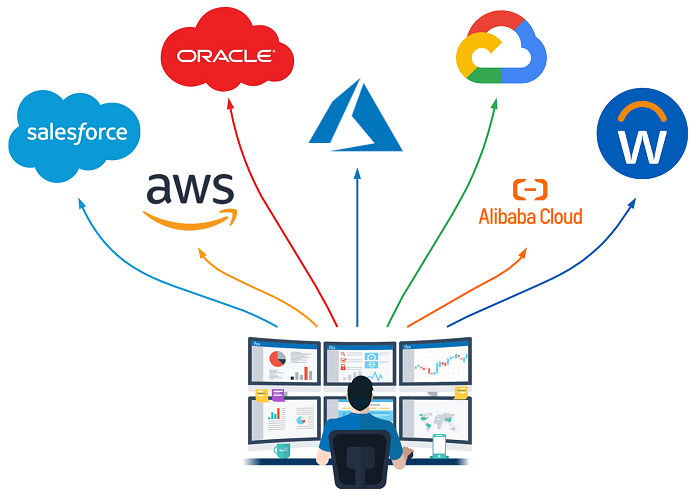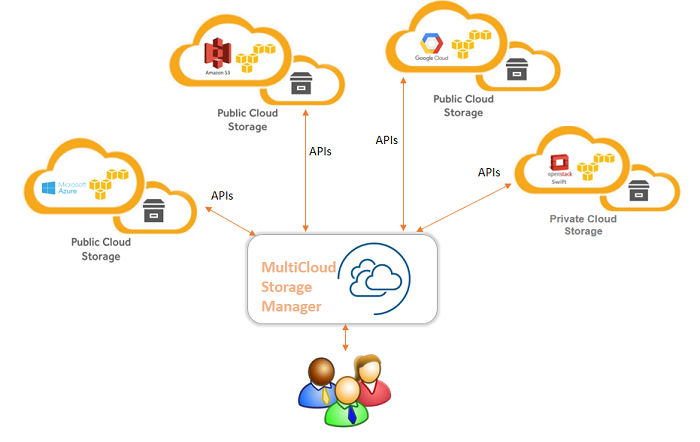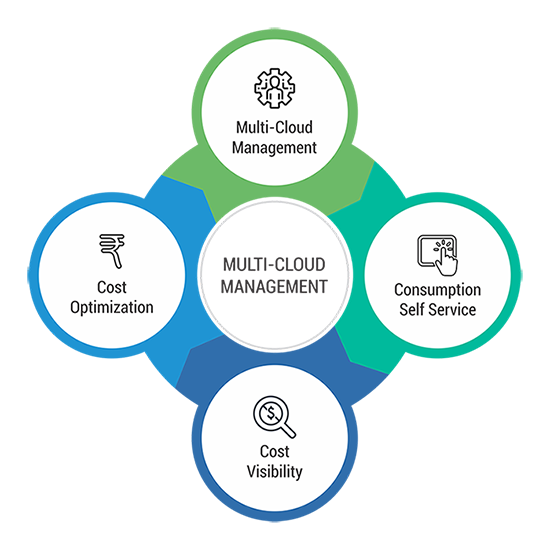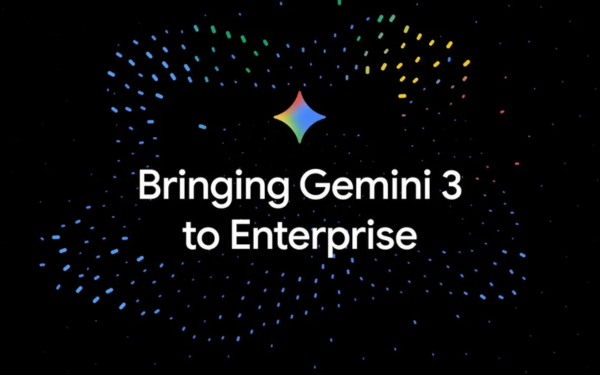What is multi-cloud? Cloud platform trends for businesses
With the fact that many businesses today believe in cloud platform, some businesses now use more than a single cloud provider, known as multi-cloud. And multi-cloud has emerged as one of the hottest trends in enterprise technology over the past few years as companies increasingly adopt public cloud platforms to host their workloads. .
What is multi-cloud?
Multi-cloud is a cloud approach made up of more than 1 cloud service, from more than 1 cloud service provider — Public or Private. It can be any combination of Infrastructure, Platform, or Software as a Service (IaaS, PaaS, or SaaS). For example, a business can use email as a service from a provider, customer relationship management (CRM) from another vendor and Infrastructure as a Service (IaaS) from another.

Multi-cloud may be for system redundancy and backup purposes only, or it may combine different cloud providers for different services.
Cloud Storage is a business data storage service provided by Google Cloud
The main technologies of multi-cloud
The multi-cloud platform optimally supports businesses by providing technologies to increase the efficiency of cloud services.
Multi-cloud containers
In multi-cloud environments, using software containers solves portability issues and accelerates application deployment.
A container is a small file that bundles the application code together with all the libraries and other dependencies it needs to run. By packing applications, libraries, environment variables, other software binaries, and configuration files together, the container ensures that it has everything it needs to run the application, regardless of the environment. active field on which the container runs.
The consistent adoption of open standards across the clouds makes containerization ideal for migrating applications within a multi-cloud infrastructure. Since the application can run in any environment, you can obtain the application's container from the on-premises environment and place it on any public cloud infrastructure for the purpose of cloud bursting, a process allows you to scale when you run out of space. In another case, if you need to run an application in different places in a multi-cloud environment, container creation allows you to do it efficiently and consistently.
Multi-cloud storage
To get the most value from a multi-cloud environment, you need a data storage strategy. You can run your storage infrastructure on-premises, in the cloud, or use a combination of the two depending on your specific needs.
Cloud storage adds flexibility and scalability, but data storage or privacy regulations may limit what types of data you can store in the cloud.

Other considerations about multi-cloud storage revolve around managing the data it's stored in. You can have multiple storage locations to keep the data as close to the user as possible, but of course, using multiple parties adds complexity. Thankfully, management solutions are available that bring consistency and order to cloud storage no matter how geographically dispersed your storage network or how many clouds it uses.
Multi-cloud automation
As IT environments span geographies and clouds, making everything work together efficiently is a priority. Automating the management of multi-cloud environments eliminates manual work and the potential for human error, improves operational efficiency and consistency, and helps employees spend time on tasks. strategic work.
Multi-cloud monitoring
While multi-cloud offers many benefits, it can create silos and add complexity, making it difficult to monitor your entire IT environment. Even if a cloud provider has monitoring, this capability is limited to that provider's cloud, which means other parts of your cloud environment are always on. redundancy from the point of view of management.
To address the issue of transparency, vendors have started introducing monitoring tools that give you a holistic view of your multi-cloud environment. You should choose a management tool as early as possible in your multi-cloud environment deployment. Attempting to manage multi-cloud without full transparency can lead to performance problems, which only become more severe the longer they persist.
Multi-cloud becomes a new trend for businesses
The development of technology entails a lot of continuous changes on the multicloud landscape, with more and more businesses tending to use and accept to avoid the situation of "keeping all eggs in the same place". basket”. According to a recent survey, up to 85% businesses use multi-cloud, on average, enterprises use 5 cloud platforms and run test projects on 3 clouds. And it can be said that multi-cloud becomes a trend because of the potential benefits for businesses.
About function
The multi-cloud architecture allows users to choose cloud services from different providers, allowing them to use what is best available for specific tasks. In today's competitive market, it's not uncommon for cloud service providers to develop a niche in a specialized field. For example, a cloud provider might stand out for data management, security profiling, or machine learning. A business can work with all three cloud providers for maximum benefit.
Flexibility
Another driver for multi-cloud adoption is to avoid vendor lock-in. Early cloud users understood this all too well. They moved their apps to the cloud, used that vendor's modules and services, and built a great system – but it didn't integrate well outside of their home infrastructure. provide cloud. Each provider wants to force customers to use only its service and so lock-in takes place as an inherent feature.
Today, developers are using containers and microservices to design portability around the cloud. Now, if the changing features don't match the price, investment costs, and cloud workloads can move more easily.
Reduce latency
Cloud inspires people to think about virtual worlds, but physical infrastructure still plays a big role in performance. When users are geographically distant from a cloud service provider's premises, performance can suffer. Latency may be measured in fractions of a second, but for some businesses, every millisecond matters. The multi-cloud architecture allows businesses with locations in different parts of the country or around the world to take advantage of the clouds closest to their users, optimizing performance.

Value and return is worth the investment cost
Importantly, cloud service providers may offer similar features, but there are still some differences that make them distinguishable from one another. For example, some offer better security for a higher price, while others are cheaper but have basic security features.
Furthermore, the multi-cloud strategy gives organizations the freedom to choose from different vendors. That way, companies can choose the ones that deliver the best value for money. After all, it all comes down to exactly what the business wants to use the cloud for.
Freedom to choose
Having multiple cloud providers to choose from often leads to a lot of benefits for businesses. First of all, it protects businesses from so-called “customer lock-ins”. Cloud service providers cannot prevent businesses from using services from their competitors with countless outstanding features. Furthermore, this guarantees companies' right to pricing and in this way they can negotiate better deals from each supplier.
Trusted Architecture
By adopting a multicloud approach, businesses can provide their customers with the same performance and speed as with applications, no matter where they are on the planet. Furthermore, the deployment of multiple cloud solutions reduces the risk of distributed denial of service attacks (DDoS) can make the entire business unable to connect and operate offline.
Multi-cloud architectures are gaining popularity for many compelling reasons, including flexibility, extensible functionality, and cost control. However, it requires a different strategy than using a single cloud platform. Migrating workloads to the cloud is already a big project – optimizing workloads in multiple clouds is even more complex. The simplest solution is to work with experts to ensure your multi-cloud strategy is optimized, working properly, and delivering the most value for your business.
Contact Gimasys for advice on conversion strategies suitable to your business's actual situation and experience the service for free Google Cloud Platform:
Hotline: Hanoi: 0987 682 505 – Ho Chi Minh: 0974 417 099
Email: gsuite@gimasys.com



